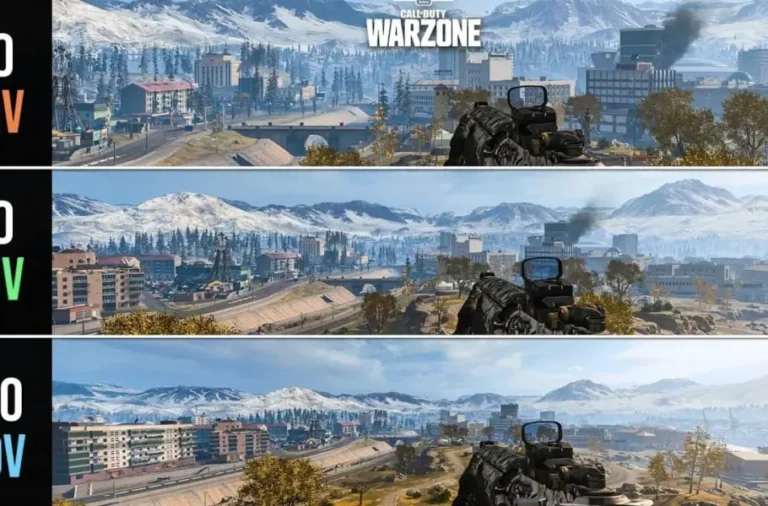Field of View (often abbreviated as FOV) is one of the most important and frequently used terms in the graphical settings of video games. It directly impacts your visual experience, immersion, and even gameplay performance.
What Is FOV?
Field of View (FOV) refers to the angle of the visible area that the in-game camera—or the character’s eyes—can capture at any given moment. It’s similar to human peripheral vision, but in video games, it’s defined digitally and can often be adjusted by the player.
In simple terms, FOV determines how much of the game world you can see on your screen—either horizontally, vertically, or both. A higher FOV means you can see more of your surroundings, while a lower FOV zooms in the view and makes the image feel more focused or compressed.
How FOV Affects Gameplay
Imagine playing a first-person shooter like Call of Duty or Half-Life. If your FOV is set high, you’ll be able to see more of the surrounding area, such as enemies sneaking from the sides or hidden items near the edges of the screen. This wider view enhances peripheral vision, which can be a huge advantage in fast-paced or competitive games.
On the other hand, a lower FOV (around 60 degrees) narrows your vision to what’s directly in front of you. While this can create a more cinematic or story-driven atmosphere, it may limit spatial awareness and even cause motion sickness for some players.
How Is FOV Measured?
FOV is usually measured in degrees. The higher the number, the wider the camera angle:
- 90° FOV: A relatively wide view, commonly used in many first-person games.
- 60° FOV: A tighter, more focused image with a reduced field of vision.
- 110° FOV or higher: Very wide view, allowing for increased spatial awareness.
It’s important to note that your perception of FOV depends on factors like your monitor type (standard or UltraWide), aspect ratio (e.g., 16:9 or 21:9), and camera angle (first-person or third-person). Some games also allow players to separately adjust horizontal (hFOV) and vertical FOV (vFOV).
FOV in First-Person vs Third-Person Games
First-Person Games
In first-person games, the camera is aligned with the character’s eyes. Therefore, FOV plays a major role in:
- How much visual information you can take in
- How quickly you can react to threats
- The overall realism and sense of immersion
For competitive games like CS:GO or Overwatch, players often increase their FOV to 100–110 degrees for faster reaction and better environmental awareness.
Third-Person Games
In third-person games, the camera is positioned behind or above the character. While FOV still matters, it typically has less impact compared to first-person games. Many third-person titles offer a wide default view, and changes to FOV are often handled automatically by the game engine.
However, raising the FOV too much in third-person games may make the character look too small or detach the camera too far, especially during close combat.
| Feature | First-Person | Third-Person |
| Camera Position | Character’s eyes | Behind or above character |
| FOV Impact | Very high | Moderate |
| Common Use | Shooters, simulators, VR | Action, RPG, platformers |
| FOV Too Low | Reduced awareness, motion sickness | Over-zoom on character |
| FOV Too High | Wide view, fast response | Cinematic scenes, wide scenery |
Horizontal vs Vertical FOV (hFOV vs vFOV)
Some games—especially PC titles—let you adjust either horizontal FOV (hFOV) or vertical FOV (vFOV):
- hFOV: Determines how much is visible from left to right, more common in PC games and widescreen monitors.
- vFOV: Determines visibility from top to bottom, more common in consoles or older engines.
These values are interconnected through your screen’s aspect ratio. For instance, the same vFOV on a 21:9 monitor will result in a much wider hFOV than on a 4:3 screen.
Does FOV Affect System Performance?
Yes—increasing FOV puts more load on your GPU and CPU because more objects, textures, lighting, and shadows need to be rendered in each frame. This is especially noticeable in open-world games like Cyberpunk 2077 or Red Dead Redemption 2.
If your system isn’t powerful or you prioritize higher frame rates, it’s recommended to keep FOV in a moderate range (around 85–95 degrees) for a balanced experience.
What’s the Best FOV Setting?
There’s no one-size-fits-all answer. The ideal FOV depends on the type of game, screen size, monitor ratio, and personal preference. Here’s a quick guideline:
| Factor | Suggested FOV |
| Fast-paced shooters | 100–110 degrees |
| Story-driven or cinematic games | 75–90 degrees |
| Large monitors | Higher FOV |
| Small monitors | Lower FOV |
| UltraWide displays | 110+ degrees |
| Standard 16:9 displays | 90–100 degrees |
Conclusion: Why FOV Matters
Field of View is one of the most impactful visual settings in any game. It can make your experience more immersive, improve your reaction time, and give you a competitive edge. While often overlooked, tuning your FOV correctly can transform a basic experience into a smooth, enjoyable, and even professional one.
